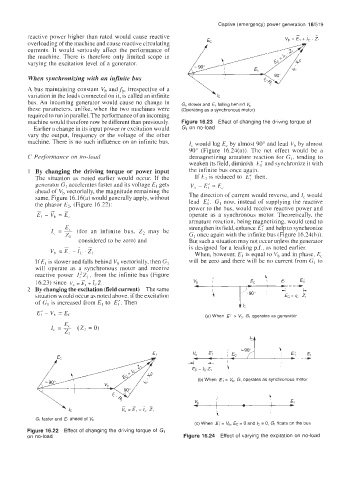Page 545 - Industrial Power Engineering and Applications Handbook
P. 545
Captive (emergency) power generation 16/519
reactive power higher than rated would cause reactive v, = El + IC . z,
overloading of the machine and cause reactive circulating F,
currents. It would seriously affect the performance of
the machine. There is therefore only limited scope in
varying the excitation level of a generator.
When synchronizing with an infinite bus
A bus maintaining constant vh and fh, irrespective of a
variation in the loads connected on it, is called an infinite
bus. An incoming generator would cause no change in GI slower and El falling behind V,
these parameters. unlike, when the two machines were (Operating as a synchronous motor)
required to run in parallel. The performance of an incoming
machine would therefore now be different than previously. Figure 16.23 Effect of changing the driving torque of
Earlier a change in its input power or excitation would GI on no-load
vary the output, frequency or the voltage of the other
machine. There is no such influence on an infinite bus. I, would lag E, by almost 90" and lead V,, by almost
90" (Figure 16.24(a)). The net effect would be a
Performance on no-loud demagnetizing armatlire reaction fnr GI, tending to
weaken its field, diminish E( and synchronize it with
By changing the driving torque or power input the infinite bus once again.
The situation as noted earlier would occur. If the If E, is reduced to E; then,
generator GI accelerates faster and its voltage El gets Vb - E; = E,
ahead of vh vectorially, the magnitude remaining the
same, Figure 16.16(a) would generally apply, without The direction of current would reverse, and I, would
the phasor E?, (Figure 16.22): lead E;. GI now, instead of supplying the reactive
_ - _ power to the bus, would receive reactive power and
El - Vh = E, operate as a synchronous motor. Theoretically, the
armature reaction, being magnetizing, would tend to
E strengthen its field, enhance E; and help to synchronize
I, = 2 (for an infinite bus, Z2 may be
ZI GI once again with the infinite bus (Figure 16.24(b)).
considered to be zero) and But such a situation may not occur unless the generator
v, = E, - r, ' 2, is designed for a leading p.f., as noted earlier.
When, however, E, is equal to V,, and in phase, E,
If E, is slower and falls behind V, vectorially, then GI will be zero and there will be no current from GI to
will operate as a synchronous motor and receive
reactive power I,?Z,, from the infinite bus (Figure
16.23) since v, = E, + i,Z,.
By changing the excitation (field current) The same
situation would occur as noted above, if the excitation
of GI is increased from El to E;. Then
+ /C
E; - v, = Ec
(a) When E; > Vb, G, operates as generatot
(b) When €; < V,, G, operates as synchronous motor
I - L;
- - - - vb I €1
v, = E, - I, .z, I
\
G1 faster and E, ahead of Vb
(c) When E; = V,, Ec = 0 and IC = 0, G1 floats on the bus
Figure 16.22 Effect of changing the driving torque of GI
on no-load Figure 16.24 Effect of varying the excitation on no-load

